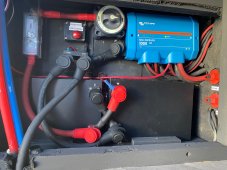Rocksnsalt
Solar Enthusiast
Hello, I’m no electrical expert and hope to get some feedback re the SOK 206ah batteries I’ve been considering for my sprinter van.
These comments were sent to me by someone much more knowledgeable than me, any comments?
It's a 200 AH battery with a 40 amp recommended charge limit. That's ridiculously small. Maybe OK for a small B2B, but not for an aux alternator. A standard 0.5C charge rate would be 100 amps, and that's what Victron specs for their 200 AH battery. Even worse, max discharge rate is 100 amps. I haven't even found what the nominal discharge rate is, it likely is as small as 50 amps. Most 120V appliances running off an inverter will need more than 100 amps, so whatever is nominal is basically unusable for van life unless you use multiple of them. These limitation are caused by a wimpy BMS and small internal wires.
These comments were sent to me by someone much more knowledgeable than me, any comments?
It's a 200 AH battery with a 40 amp recommended charge limit. That's ridiculously small. Maybe OK for a small B2B, but not for an aux alternator. A standard 0.5C charge rate would be 100 amps, and that's what Victron specs for their 200 AH battery. Even worse, max discharge rate is 100 amps. I haven't even found what the nominal discharge rate is, it likely is as small as 50 amps. Most 120V appliances running off an inverter will need more than 100 amps, so whatever is nominal is basically unusable for van life unless you use multiple of them. These limitation are caused by a wimpy BMS and small internal wires.






